ECU CHEVROLET S10 2003 2.G Owners Manual
[x] Cancel search | Manufacturer: CHEVROLET, Model Year: 2003, Model line: S10, Model: CHEVROLET S10 2003 2.GPages: 432, PDF Size: 2.82 MB
Page 7 of 432
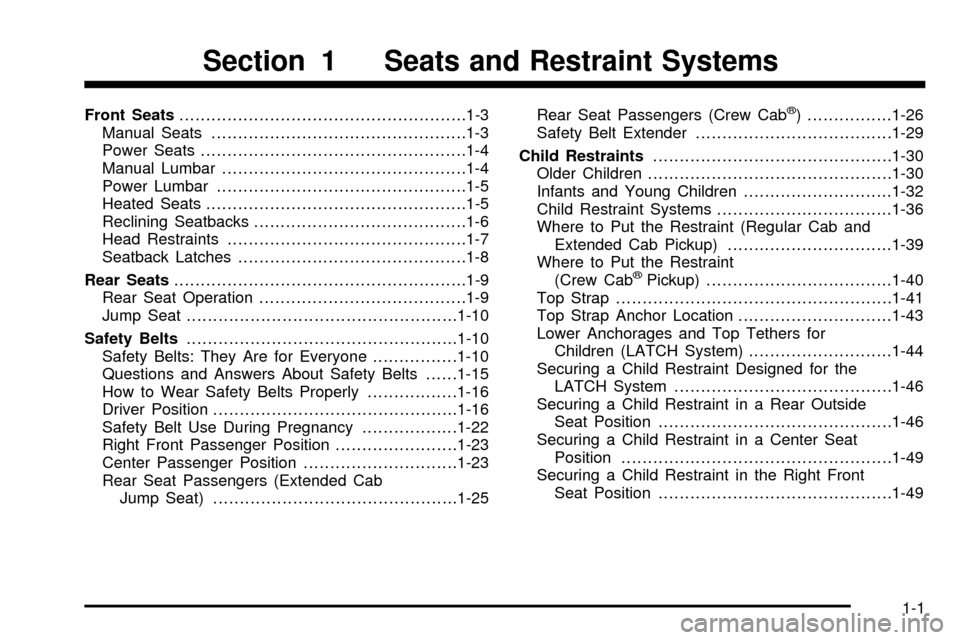
Front Seats......................................................1-3
Manual Seats................................................1-3
Power Seats..................................................1-4
Manual Lumbar..............................................1-4
Power Lumbar...............................................1-5
Heated Seats.................................................1-5
Reclining Seatbacks........................................1-6
Head Restraints.............................................1-7
Seatback Latches...........................................1-8
Rear Seats.......................................................1-9
Rear Seat Operation.......................................1-9
Jump Seat...................................................1-10
Safety Belts...................................................1-10
Safety Belts: They Are for Everyone................1-10
Questions and Answers About Safety Belts......1-15
How to Wear Safety Belts Properly.................1-16
Driver Position..............................................1-16
Safety Belt Use During Pregnancy..................1-22
Right Front Passenger Position.......................1-23
Center Passenger Position.............................1-23
Rear Seat Passengers (Extended Cab
Jump Seat)..............................................1-25Rear Seat Passengers (Crew Cabž) ................1-26
Safety Belt Extender.....................................1-29
Child Restraints.............................................1-30
Older Children..............................................1-30
Infants and Young Children............................1-32
Child Restraint Systems.................................1-36
Where to Put the Restraint (Regular Cab and
Extended Cab Pickup)...............................1-39
Where to Put the Restraint
(Crew Cab
žPickup)...................................1-40
Top Strap....................................................1-41
Top Strap Anchor Location.............................1-43
Lower Anchorages and Top Tethers for
Children (LATCH System)...........................1-44
Securing a Child Restraint Designed for the
LATCH System.........................................1-46
Securing a Child Restraint in a Rear Outside
Seat Position............................................1-46
Securing a Child Restraint in a Center Seat
Position...................................................1-49
Securing a Child Restraint in the Right Front
Seat Position............................................1-49
Section 1 Seats and Restraint Systems
1-1
Page 23 of 432
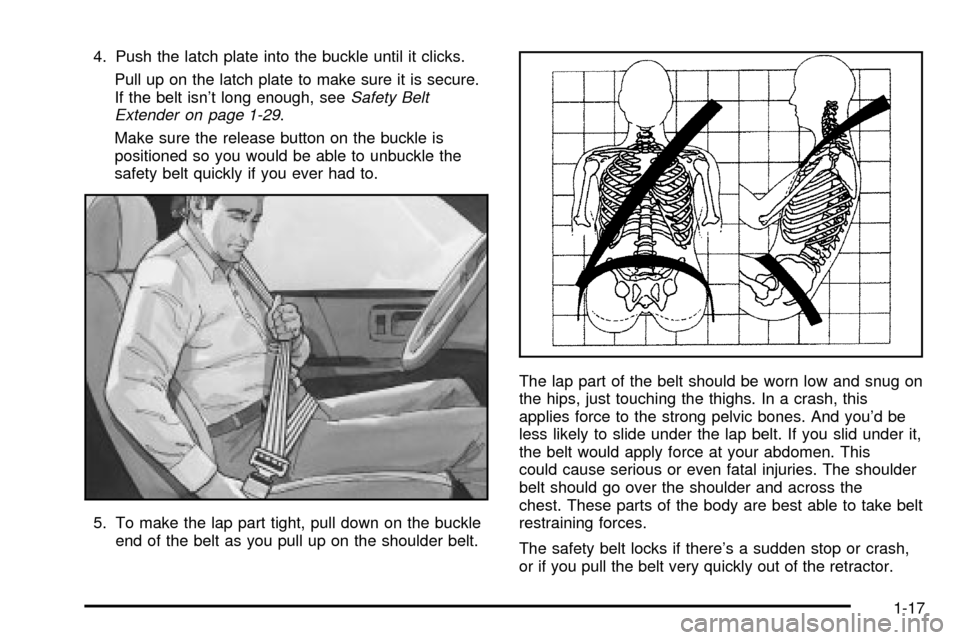
4. Push the latch plate into the buckle until it clicks.
Pull up on the latch plate to make sure it is secure.
If the belt isn't long enough, see
Safety Belt
Extender on page 1-29.
Make sure the release button on the buckle is
positioned so you would be able to unbuckle the
safety belt quickly if you ever had to.
5. To make the lap part tight, pull down on the buckle
end of the belt as you pull up on the shoulder belt.The lap part of the belt should be worn low and snug on
the hips, just touching the thighs. In a crash, this
applies force to the strong pelvic bones. And you'd be
less likely to slide under the lap belt. If you slid under it,
the belt would apply force at your abdomen. This
could cause serious or even fatal injuries. The shoulder
belt should go over the shoulder and across the
chest. These parts of the body are best able to take belt
restraining forces.
The safety belt locks if there's a sudden stop or crash,
or if you pull the belt very quickly out of the retractor.
1-17
Page 33 of 432

Lap-Shoulder Belt
The positions next to the windows have lap-shoulder
belts. Here's how to wear one properly.
1. Pick up the latch plate and pull the belt across you.
Don't let it get twisted.
The shoulder belt may lock if you pull the belt
across you very quickly. If this happens, let the belt
go back slightly to unlock it. Then pull the belt
across you more slowly.2. Push the latch plate into the buckle until it clicks.
Pull up on the latch plate to make sure it is secure.
When the shoulder belt is pulled out all the way,
it will lock. If it does, let it go back all the way and
start again.
If the belt is not long enough, see
Safety Belt
Extender on page 1-29.
Make sure the release button on the buckle is
positioned so you would be able to unbuckle the
safety belt quickly if you ever had to.
1-27
Page 39 of 432
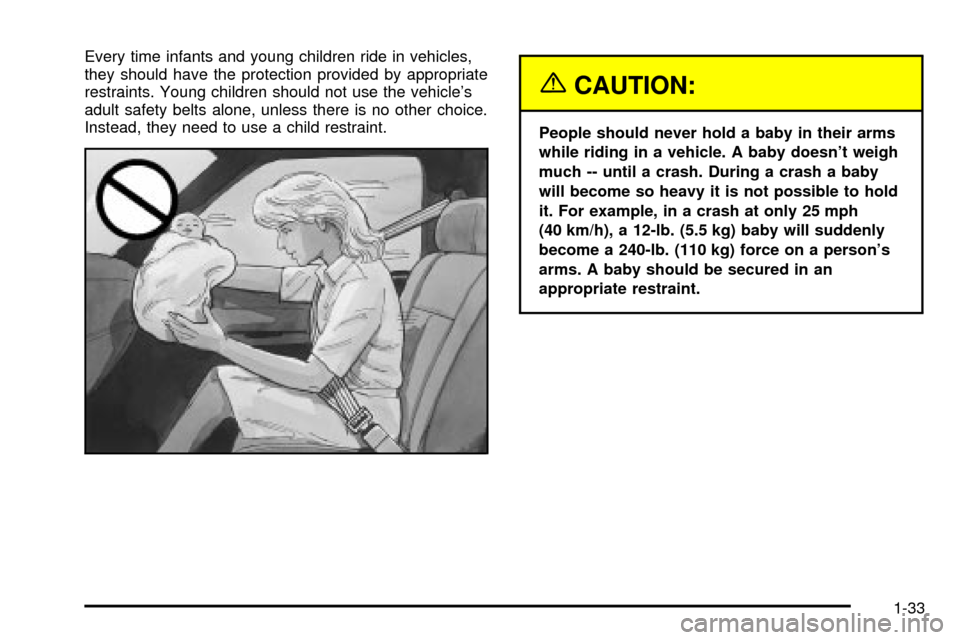
Every time infants and young children ride in vehicles,
they should have the protection provided by appropriate
restraints. Young children should not use the vehicle's
adult safety belts alone, unless there is no other choice.
Instead, they need to use a child restraint.
{CAUTION:
People should never hold a baby in their arms
while riding in a vehicle. A baby doesn't weigh
much -- until a crash. During a crash a baby
will become so heavy it is not possible to hold
it. For example, in a crash at only 25 mph
(40 km/h), a 12-lb. (5.5 kg) baby will suddenly
become a 240-lb. (110 kg) force on a person's
arms. A baby should be secured in an
appropriate restraint.
1-33
Page 41 of 432
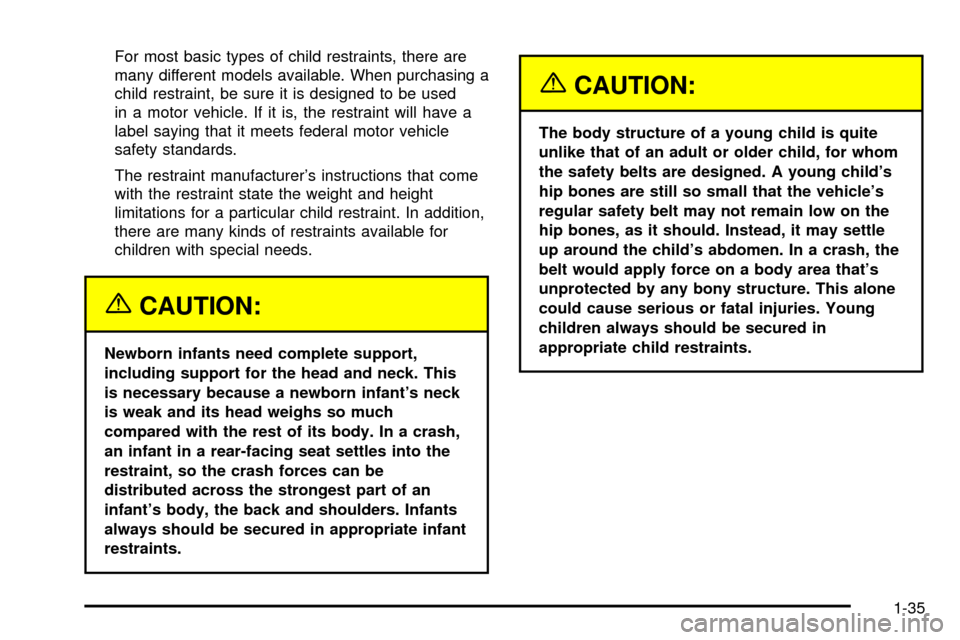
For most basic types of child restraints, there are
many different models available. When purchasing a
child restraint, be sure it is designed to be used
in a motor vehicle. If it is, the restraint will have a
label saying that it meets federal motor vehicle
safety standards.
The restraint manufacturer's instructions that come
with the restraint state the weight and height
limitations for a particular child restraint. In addition,
there are many kinds of restraints available for
children with special needs.
{CAUTION:
Newborn infants need complete support,
including support for the head and neck. This
is necessary because a newborn infant's neck
is weak and its head weighs so much
compared with the rest of its body. In a crash,
an infant in a rear-facing seat settles into the
restraint, so the crash forces can be
distributed across the strongest part of an
infant's body, the back and shoulders. Infants
always should be secured in appropriate infant
restraints.
{CAUTION:
The body structure of a young child is quite
unlike that of an adult or older child, for whom
the safety belts are designed. A young child's
hip bones are still so small that the vehicle's
regular safety belt may not remain low on the
hip bones, as it should. Instead, it may settle
up around the child's abdomen. In a crash, the
belt would apply force on a body area that's
unprotected by any bony structure. This alone
could cause serious or fatal injuries. Young
children always should be secured in
appropriate child restraints.
1-35
Page 44 of 432
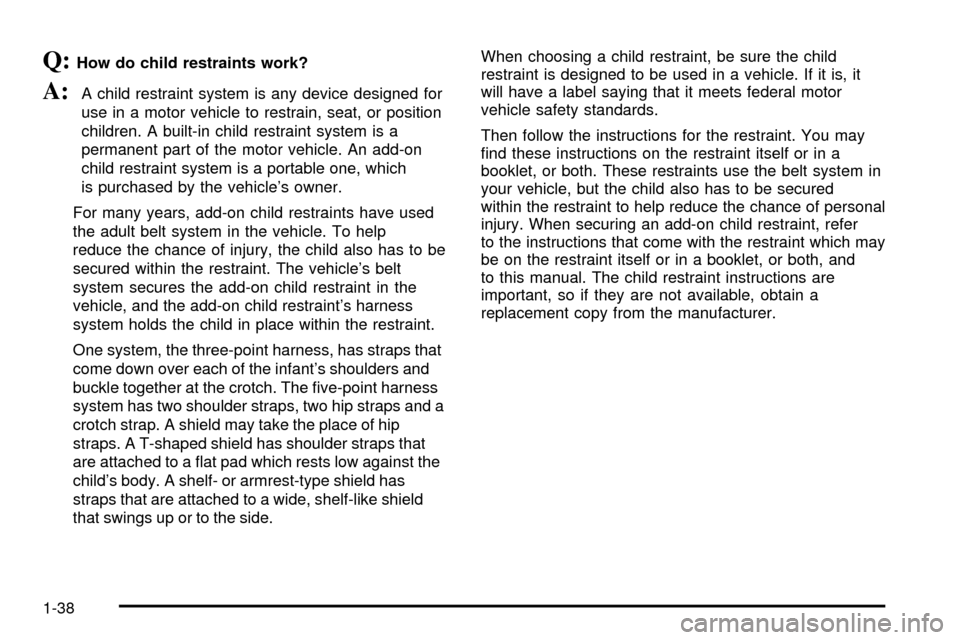
Q:How do child restraints work?
A:A child restraint system is any device designed for
use in a motor vehicle to restrain, seat, or position
children. A built-in child restraint system is a
permanent part of the motor vehicle. An add-on
child restraint system is a portable one, which
is purchased by the vehicle's owner.
For many years, add-on child restraints have used
the adult belt system in the vehicle. To help
reduce the chance of injury, the child also has to be
secured within the restraint. The vehicle's belt
system secures the add-on child restraint in the
vehicle, and the add-on child restraint's harness
system holds the child in place within the restraint.
One system, the three-point harness, has straps that
come down over each of the infant's shoulders and
buckle together at the crotch. The ®ve-point harness
system has two shoulder straps, two hip straps and a
crotch strap. A shield may take the place of hip
straps. A T-shaped shield has shoulder straps that
are attached to a ¯at pad which rests low against the
child's body. A shelf- or armrest-type shield has
straps that are attached to a wide, shelf-like shield
that swings up or to the side.When choosing a child restraint, be sure the child
restraint is designed to be used in a vehicle. If it is, it
will have a label saying that it meets federal motor
vehicle safety standards.
Then follow the instructions for the restraint. You may
®nd these instructions on the restraint itself or in a
booklet, or both. These restraints use the belt system in
your vehicle, but the child also has to be secured
within the restraint to help reduce the chance of personal
injury. When securing an add-on child restraint, refer
to the instructions that come with the restraint which may
be on the restraint itself or in a booklet, or both, and
to this manual. The child restraint instructions are
important, so if they are not available, obtain a
replacement copy from the manufacturer.
1-38
Page 45 of 432

Where to Put the Restraint (Regular
Cab and Extended Cab Pickup)
The child restraint must be secured properly in the right
front passenger seat. If you want to secure a
rear-facing child restraint in the right front passenger's
seat, turn off the passenger's air bag. See
Air Bag
Off Switch on page 1-61andSecuring a Child Restraint
in the Right Front Seat Position on page 1-49for
more on this, including important safety information.
{CAUTION:
A child in a rear-facing child restraint can be
seriously injured or killed if the right front
passenger's air bag in¯ates. This is because
the back of the rear-facing child restraint
would be very close to the in¯ating air bag. Be
sure to turn off the air bag before using a
rear-facing child restraint in the right front seat
position.
Even though the AIR BAG OFF switch is
designed to turn off the passenger's frontal air
bag, no system is fail-safe, and no one can
guarantee that an air bag will not deploy under
some unusual circumstance, even though it is
turned off. General Motors therefore
recommends that rear-facing child restraints
be transported in vehicles with a rear seat that
will accommodate a rear-facing child restraint,
whenever possible.
1-39
Page 46 of 432
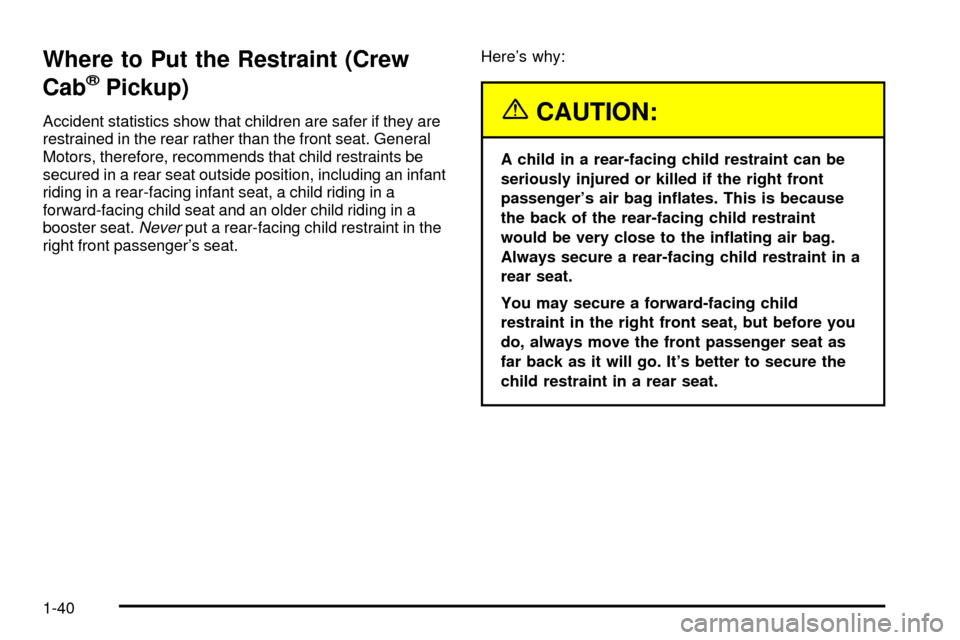
Where to Put the Restraint (Crew
Cab
žPickup)
Accident statistics show that children are safer if they are
restrained in the rear rather than the front seat. General
Motors, therefore, recommends that child restraints be
secured in a rear seat outside position, including an infant
riding in a rear-facing infant seat, a child riding in a
forward-facing child seat and an older child riding in a
booster seat.
Neverput a rear-facing child restraint in the
right front passenger's seat.Here's why:
{CAUTION:
A child in a rear-facing child restraint can be
seriously injured or killed if the right front
passenger's air bag in¯ates. This is because
the back of the rear-facing child restraint
would be very close to the in¯ating air bag.
Always secure a rear-facing child restraint in a
rear seat.
You may secure a forward-facing child
restraint in the right front seat, but before you
do, always move the front passenger seat as
far back as it will go. It's better to secure the
child restraint in a rear seat.
1-40
Page 47 of 432
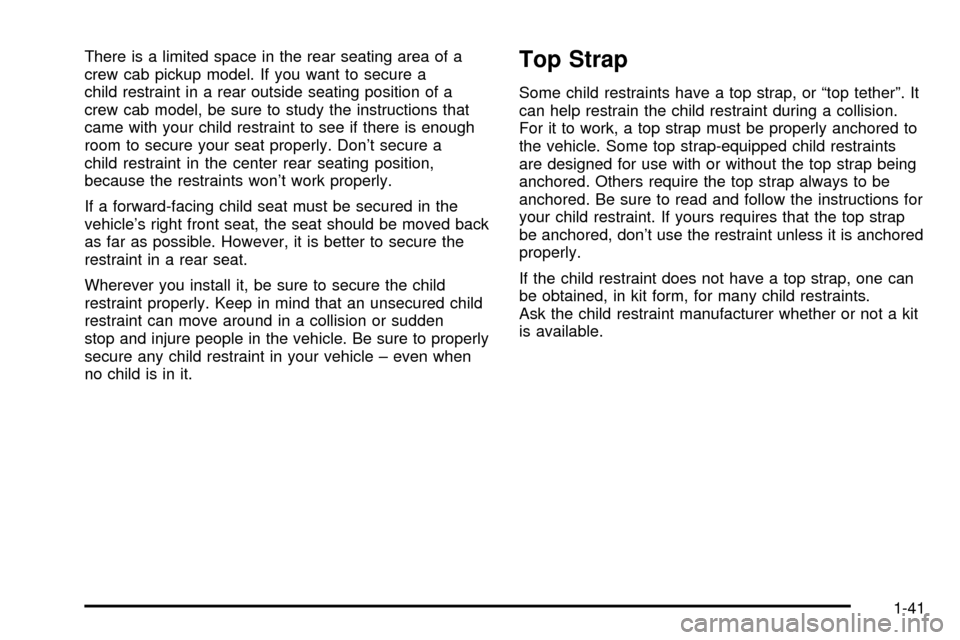
There is a limited space in the rear seating area of a
crew cab pickup model. If you want to secure a
child restraint in a rear outside seating position of a
crew cab model, be sure to study the instructions that
came with your child restraint to see if there is enough
room to secure your seat properly. Don't secure a
child restraint in the center rear seating position,
because the restraints won't work properly.
If a forward-facing child seat must be secured in the
vehicle's right front seat, the seat should be moved back
as far as possible. However, it is better to secure the
restraint in a rear seat.
Wherever you install it, be sure to secure the child
restraint properly. Keep in mind that an unsecured child
restraint can move around in a collision or sudden
stop and injure people in the vehicle. Be sure to properly
secure any child restraint in your vehicle ± even when
no child is in it.Top Strap
Some child restraints have a top strap, or ªtop tetherº. It
can help restrain the child restraint during a collision.
For it to work, a top strap must be properly anchored to
the vehicle. Some top strap-equipped child restraints
are designed for use with or without the top strap being
anchored. Others require the top strap always to be
anchored. Be sure to read and follow the instructions for
your child restraint. If yours requires that the top strap
be anchored, don't use the restraint unless it is anchored
properly.
If the child restraint does not have a top strap, one can
be obtained, in kit form, for many child restraints.
Ask the child restraint manufacturer whether or not a kit
is available.
1-41
Page 48 of 432
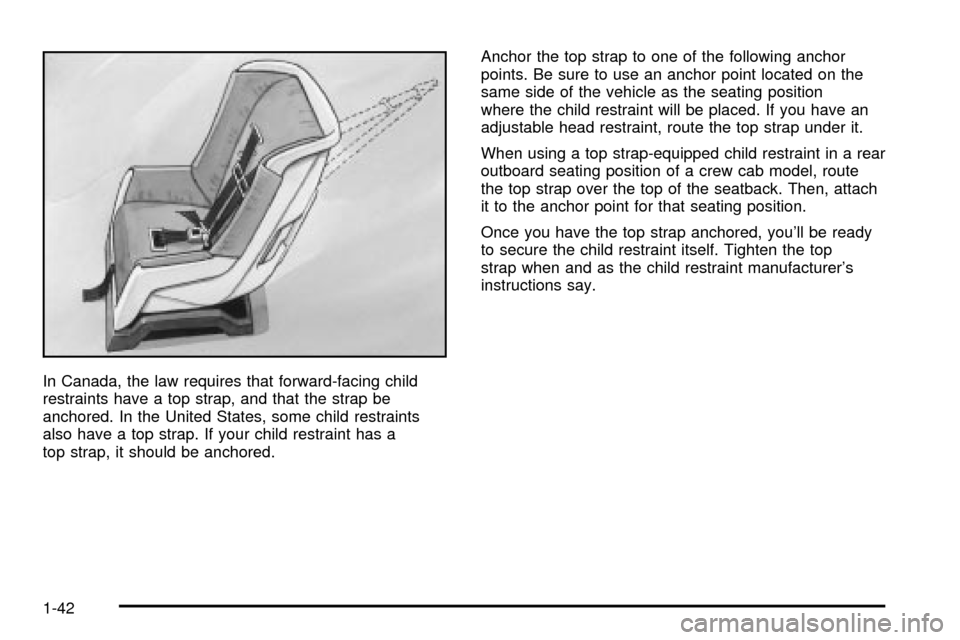
In Canada, the law requires that forward-facing child
restraints have a top strap, and that the strap be
anchored. In the United States, some child restraints
also have a top strap. If your child restraint has a
top strap, it should be anchored.Anchor the top strap to one of the following anchor
points. Be sure to use an anchor point located on the
same side of the vehicle as the seating position
where the child restraint will be placed. If you have an
adjustable head restraint, route the top strap under it.
When using a top strap-equipped child restraint in a rear
outboard seating position of a crew cab model, route
the top strap over the top of the seatback. Then, attach
it to the anchor point for that seating position.
Once you have the top strap anchored, you'll be ready
to secure the child restraint itself. Tighten the top
strap when and as the child restraint manufacturer's
instructions say.
1-42